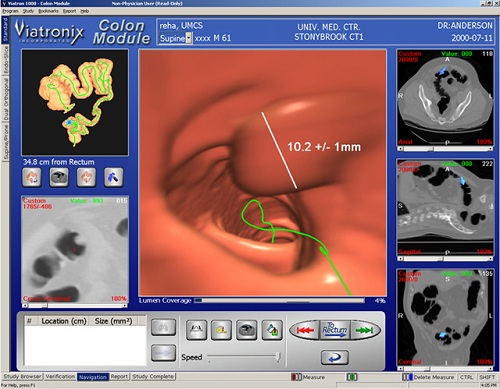Virtual Colonoscopy to Become the Standard to Detect Colon Cancer?
Posted on
Whether the most technologically advanced way to check for colon cancer will become the standard screening method of the future does not appear to be a slam-dunk.
The method, known as virtual colonoscopy, combines X-ray and computer technology to create three-dimensional views of the full length of the colon, the large intestine. It allows doctors to look for polyps, or pre-cancerous growths, or other signs of cancer or other intestinal disease. According to the U.S. National Cancer Institute, virtual colonoscopy can be done with computed tomography (called a CT or CAT scan) or with magnetic resonance imaging (MRI).
Colon cancer is one of the few types of preventable cancer, with doctors able to find and remove pre-cancerous polyps in the colon before cancer can develop. The current “gold standard” procedure for colon cancer screening, however, is colonoscopy, a time-consuming procedure for which preparation is unpleasant and sedation is necessary.
Perhaps because of this, only half of all people older than 50 have gotten this potentially life-saving test for colon cancer, according to the U.S. Centers for Disease Control and Prevention.
Doctors who tout the virtual form of colonoscopy argue that it takes less time and does not require sedation and is a more comfortable procedure for those having it.
Yet others contend that its drawbacks far outweigh its benefits.
“It’s a test that has a tremendous number of questions still yet to be answered,” said Dr. David A. Johnson, chief of gastroenterology at Eastern Virginia Medical School, past president of the American College of Gastroenterology and co-author of the group’s guidelines for colon cancer screening.
Virtual colonoscopy, however, has advanced far enough that it’s now recommended as a frontline screening test by the American Cancer Society and as an alternative to regular colonoscopy by the American College of Gastroenterology.
I postponed my first test a few more years than I should have, but I have to say it was not a bad procedure. Now, the colon prep is a different sotry since you take powerful laxatives and the abdominal cramping is not fun.
But, you have to do the same prep in cleaning out your colon before the virtual colonoscopy anyway.
If the virtual test allows more patients to receive “some” colon cancer screening, then this is a good thing. I am positive the virtual tests will only improve with the technology and time.
Researchers also are working to make virtual colonoscopy even better, Yee said. New computerized, post-processing techniques are being developed to improve the test’s accuracy and lower the radiation dose, and doctors are working to develop a form of the test for which the patient would not need to take laxatives in advance.
At the moment, though, the American College of Gastroenterology still would prefer that people have a conventional colonoscopy done every 10 years because, as Johnson said, it’s a better test that allows doctors to immediately remove any polyps that are found.
However, if the drawbacks of a normal colonoscopy are enough to dissuade a person from undergoing colon cancer screening, then they should consider virtual colonoscopy as an alternative test that they should have every five years, according to ACG guidelines.

